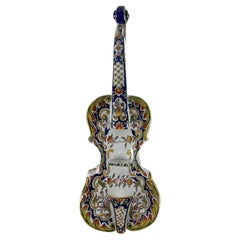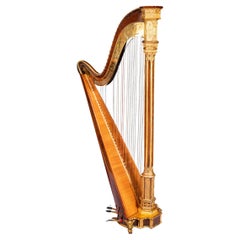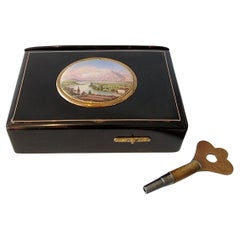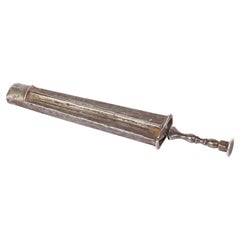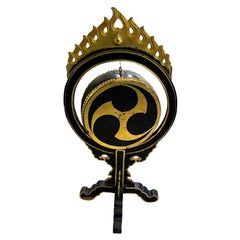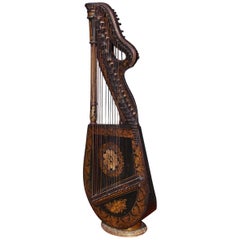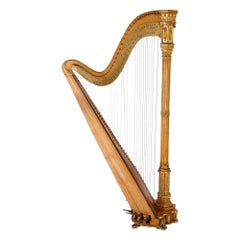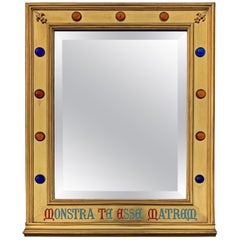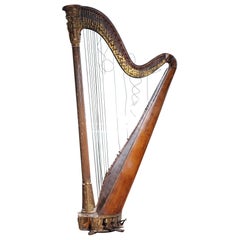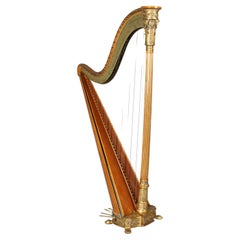Early 19th Century Musical Instruments
to
2
9
2
12
1
1
1
13
150
339
90
108
138
53
19
6
8
19
13
28
27
30
7
5
7
6
3
2
2
8
5
4
2
1
12
12
12
1
1
Period: Early 19th Century
Violin In Majolica Manufacture Rouen Early 1800s French Musical Ceramics
By Rouen
Located in Milano, MI
French Faience Violin Manufacture of Rouen Beginning 1800 with a side pocket and two holes for hanging on the wall by means of a string, missing. This stanniferous glaze majolica vi...
Category
Baroque Antique Early 19th Century Musical Instruments
Materials
Majolica
Early 19th Century Parcel Gilt Gothic Revival Harp By Sebastian Erard
Located in Dublin, IE
A very fine and elegant Regency Satinwood and parcel-gilt double action Harp from the workshop of the famous harp and piano maker Sebastian Erard (1752-1831), decorated in the Grecia...
Category
English Gothic Revival Antique Early 19th Century Musical Instruments
Materials
Brass
Singing Bird Box by Rochat in Tortoiseshell, Gold and enamel
Located in London, GB
An early Rochat singing bird box with fusee automaton movement numbered 316 and with stamped three tulip mark in the top plate of the movement. The tortoiseshell case with hinged snuff ( or key) compartment to the rear of the box. The gold lid is finely hand painted in enamel with an excellent alpine scene with a mountain in the background, a lake in the forground. The bezel surrounding the grille through which the bird pops up and down is also of gold. The underside of the lid is also beautifully painted with a posie of flowers on a light blue background. The bird, typically for Rochat, is of a large size for a singing bird box and the grille is typical of Rochat's work rather than Bruguier's. The top of the case with a fine border made from gold. The key wound chain driven fusee movement working the bellows & driving multiple cams that on sliding the operating lever to the front, the lid opens and the bird pops up, sings its head off and 1/ turns its head from left to right, 2/ flaps the wings and finally 3/ pirouettes left and right. On completion of his 20 second performance he drops through the superbly pierced silver gilt grille and the lid closes after him. All fusee movements allow the bird a longer performance than the later spring barrel movements but more importantly one extra manipulation, the movement of the head from left to right. Frères Rochat...
Category
Antique Early 19th Century Musical Instruments
Materials
Gold, Enamel
Georgian Rare Steel Cased Tuning Fork
Located in Bishop's Stortford, Hertfordshire
A very unusual and rare Georgian antique steel cased tuning fork dating from around 1800. A wonderful piece of musical interest and history the tuning fork...
Category
English George III Antique Early 19th Century Musical Instruments
Materials
Steel
Japanese Inari Fox Fire Shinto Shrine Temple Edo Period Taiko Drum on Stand
Located in Studio City, CA
This is a truly wonderful and rather unique piece. We can't find another quite like it.
We were told it is from an Edo period Shinto Shrine dedicated to the deity Inari - a popular deity associated with foxes who were known for protecting the annual rice harvest from threatening vermin. In Japanese mythology, foxes are supposed to breathe out flames which are represented by the flame motif at the top of the drum stand...
Category
Japanese Edo Antique Early 19th Century Musical Instruments
Materials
Paint, Wood
English Regency Gilt Figural and Ebonized Dital Harp, Maker E. Light, Circa 1815
Located in Charleston, SC
English Regency gilt stenciled figural and floral ebonized dital harp signed by maker Edward Light. Retailed at Srohl Foley place London, Early 19th century.
Category
English Regency Antique Early 19th Century Musical Instruments
Materials
String, Wood, Ebony, Giltwood
English Gothic Style Ibach Upright Piano Carved Oak Traditional Folk Art Motifs
Located in Leeds, GB
English Gothic style, 1895, Ibach upright piano with a carved, oak case and ornate brass candlesticks and handles. Cabinet features traditional folk art motifs and carvings.
Pilasters carved with hearts and stylised trees. Piano cheeks feature a carved sun in a half hex and stylised bird in flight.
Front panel inlaid with folk elements including trinity tulips symbolising faith, hope and charity in a central urn with stylised foliage.
Piano legs are turned with carved spiraling detail .
Piano pedals feature a raised, ornate brass footplate in a curlicue design.
Repeating, carved barrel vaults...
Category
German Gothic Revival Antique Early 19th Century Musical Instruments
Materials
Brass
Antique coin-operated large double singing birds-in-cage, by Bontems
Located in London, GB
An antique coin-operated large double singing birds-in-cage, by Bontems,
French
circa 1900
Spend a penny in style
When wound and a 1d. coin inse...
Category
French Antique Early 19th Century Musical Instruments
Materials
Gesso
Museum Lyre Grand Piano by J.C Schleip Berlin from 1825, Empire
Located in Berlin, DE
Lyre piano attributed to Johann Christian Schleip, Berlin, around 1825, case veneered with mahogany, upper part in the form of a large lyre with 7 wooden sides (lyre), cover and chee...
Category
German Antique Early 19th Century Musical Instruments
Materials
Bronze
$22,920 Sale Price
20% Off
Antique 19th Century Regency Grand Military Drum c.1820
Located in Royal Tunbridge Wells, Kent
Antique 19th Century Regency grand military drum, dating to around the 1820. Made from wood, with brass stud work, this drum is painted with a Rule Britannia insignia. The top has a ...
Category
British Other Antique Early 19th Century Musical Instruments
Materials
Brass
Bates Pianoforte Circa 1825 Carved Baluster Leg 78 Note Fabric Panel
Located in Leeds, GB
Circa 1825, Bates pianoforte. Name plaque in a calligraphy font, sits above the keyboard surrounded by wooden beading. The tall cabinet features a rectangular, cut-out front panel that acts as a sound...
Category
English Antique Early 19th Century Musical Instruments
Materials
Fabric, Wood
Print of Timorese Ladies Playing Harp & Drinking Tea in Kupang, Indonesia, 1825
Located in Langweer, NL
Antique print, titled: 'Coupang: Ile Timor. Divers Costumes.' - ('Coupang, Timor Island. Various costumes').
Three figures in the native dress of the Indonesian island Timor. A y...
Category
Antique Early 19th Century Musical Instruments
Materials
Paper
$345 Sale Price
20% Off
Related Items
Antique Gothic Revival Harp by Erard
Located in London, GB
Antique Gothic Revival harp by Erard
French, c. 1880
Height 178cm, width 54cm, depth 91cm
Of typical form by the famed instrument maker Érard. ...
Category
French Gothic Revival Antique Early 19th Century Musical Instruments
Materials
Brass
Gothic Revival Gilt Brass on Wood Wall Mirror with Glass Stones and Latin Phrase
Located in Lisse, NL
For the collectors of rare, beautiful, meaningful and usable Gothic Revival antiques.
At the bottom of this strikingly colorful and stylish Gothic mirror is the Latin phrase Monstra...
Category
French Gothic Revival Antique Early 19th Century Musical Instruments
Materials
Brass
$2,757
H 25 in W 20 in D 2 in
French Late 19th Century Neo Gothic Gilded Metal Saint Statue
Located in Buisson, FR
Wonderful gilded metal saint statue with beautiful expression.
France, circa 1880-1900.
Weathered. Measurements include the wooden base.
Category
French Gothic Revival Antique Early 19th Century Musical Instruments
Materials
Metal
$293 Sale Price
50% Off
H 14.57 in W 5.52 in D 2.76 in
1800s Veterinarians Horse Gag and Cutaway Skull
Located in Peekskill, NY
This is an early medical school demonstration model. The horse skull on its own very interesting. It shows a professionally done cutaway of the skull showing the teeth below the gum ...
Category
American Industrial Antique Early 19th Century Musical Instruments
Materials
Bone
Rare Cigar Case in Bench Form
Located in Mexico City, CDMX
circa 1970. We offer this Rare Cigar Case in Bench Form.
Category
North American Mid-Century Modern Vintage Early 19th Century Musical Instruments
Materials
Metal
Birds a Collection of 25 Bird Figures and Music Boxes
Located in New York, NY
A lifetime collection of birds. A set of 25 some made of porcelain some carved from wood or resin. Of the 25 of them 5 are music boxes.
I actually think it's quite charming.
Siz...
Category
Early 19th Century Musical Instruments
Materials
Porcelain, Resin, Wood
RARE ANTiQUE GEORGE III SHAGREEN GLASSES SPECTACLES CASE AND FOLDING GLASSES
Located in West Sussex, Pulborough
Royal House Antiques
Royal House Antiques is delighted to offer for sale this absolutely stunning George III Shargeen & Silver Spectacles case with folding glasses...
Category
European George III Antique Early 19th Century Musical Instruments
Materials
Glass
$892
H 5.12 in W 2.17 in D 0.79 in
Japanese 19th Century Temple Gong
Located in Hudson, NY
Japanese 19th century temple gong. Temple gongs were originally used to beckon the gods. Comes with bronze bell, silk pillow, red lacquer stand and s...
Category
Japanese Antique Early 19th Century Musical Instruments
Materials
Bronze
Edo Period Samurai Suit Of Armor
Located in New Orleans, LA
This exquisite Tetsusabiji Uchidashi Gomai Dou Gusoku (Five-Plate Russet Iron Embossed Cuirass Armor), crafted in the 18th century, exemplifies the pinnacle of Edo-period samurai arm...
Category
Asian Edo Antique Early 19th Century Musical Instruments
Materials
Copper, Iron
Antique Gothic Revival Silvered Bronze Crucifix with a Gilt Bronze Corpus Christ
Located in Lisse, NL
Good size and impressive make, Gothic church altar crucifix.
This ornate and all hand-crafted, bronze table crucifix comes with a good quality made a...
Category
French Gothic Revival Early 19th Century Musical Instruments
Materials
Brass, Bronze
$1,666
H 21.5 in W 10.6 in D 5.2 in
Fine 19th Century French Neo-Gothic Gilt Metal Cathedral Church Reliquary Pair
Located in Forney, TX
A stunning pair of very fine quality French Neo-Gothic gilt metal church reliquaries. circa 1860s
Most impressive objets d’art, born in France in the second half of the 19th century, most likely Parisian gilded bronze and brass ormolu work, exceptionally executed sculptural form, the exquisitely detailed architectural cathedral shaped case having a removable pointed steeple roof with cross finial, opening to relic display case surrounded on all sides by original glazed glass panes, stepped base, rising on disc feet. Signed, stamped by maker / bronzier "BC" (unknown) model "5096" and other faint marks to lid interiors.
Additional photos available upon request
Dimensions: (approx)
14.75" High, 6.75" Wide, 6.75" Deep; 13.25 lbs total
History:
A reliquary (also referred to as a shrine, by the French term châsse or monstrance) is a container for important religious relics.
The earliest reliquaries were essentially boxes, either simply box-shaped or based on an architectural design, taking the form of a model of a church with a pitched roof. These latter are known by the French term chasse, and typical examples from the 12th to 14th century have wooden frameworks with gilt-copper plaques nailed on, decorated in champlevé enamel. Limoges was the largest production centre; NB the English usage differs from that of the French châsse, which denotes large size rather than shape.
Relics of the True Cross became very popular from the 9th century onward and were housed in magnificent gold and silver cross-shaped reliquaries decorated with enamels and precious stones. From about the end of the 10th century, reliquaries in the shape of the relics they housed also became popular; hence, for instance, the skull of Pope Alexander I was housed in a head-shaped reliquary. Similarly, the bones of saints were often housed in reliquaries that recalled the shape of the original body part, such as an arm or a foot.
A philatory is a transparent reliquary designed to contain and exhibit the bones and relics of saints. This style of reliquary has a viewing portal to view the relic inside. The feretrum was a medieval form of reliquary or shrine containing the sacred effigies and relics of a saint.
During the later Middle Ages, the monstrance form, primarily used for consecrated hosts, was sometimes used for reliquaries. These housed the relic in a rock crystal, or glass capsule mounted on a column above a base, enabling the relic to be displayed to the faithful. Reliquaries in the form of large pieces of metalwork jewellery also appeared around this time, housing tiny relics such as pieces of the Holy Thorn, notably the Holy Thorn Reliquary now in the British Museum.
Condition:
Superb museum quality examples, in excellent original unrestored antique condition with beautifully aged patina. Wear consistent with age and use. Heavily patinated - scattered oxidation. Overall wonderful examples.
Typically reliquaries were not sold in pairs, so to find a matching pair such as this is exceptionally rare.
Worldwide shipping available
Local pickup available near Dallas, Texas
Additional:
We here at Lynx Hollow Antiques love religious antiques, from Christian tabernacles, Catholic altarpiece, life-size Buddhist temple sculptures, Hindu votive offerings, 16th century Islamic mosque architectural salvaged windows...
Category
French Gothic Revival Antique Early 19th Century Musical Instruments
Materials
Brass, Bronze
$6,500 / set
H 14.75 in W 6.75 in D 6.75 in
Antique Root Bowl, Wabi Sabi Style, Scandinavia 1800s
Located in Hønefoss, 30
A unique and large root bowl from Norway, Scandinavia, dated 1818. In good vintage condition showing beautiful patina from age and use.
Category
Norwegian Romantic Antique Early 19th Century Musical Instruments
Materials
Wood
Previously Available Items
Early 19th Century Regency Satin & Gilt Wood Harp Country House
Located in Lowestoft, GB
A wonderfully decorative early 19th century harp, decorated with gesso applied grecian figures and motifs.
The harp has had a hard life, with elderly repairs, knocks and plenty of ...
Category
British Regency Antique Early 19th Century Musical Instruments
Materials
Satinwood
Antique Harpe, Brimmeyr à Paris, Year Of Manufacture: 1826
Located in Greven, DE
Antique harp by Brimmeyr
Workshop Brimmeyr à Paris
wood, stucco
around 1826
Dimensions: H x W x D: 167 x 47 x 80 cm
Description:
Beautiful and extremely elegant pedal harp with 43 strings from the workshop of the famous harp maker Brimmeyr in Paris.
The base of the instrument, standing on paw feet, is elaborately stuccoed with palmettes, hippocamps and lyres. On the back are seven fold...
Category
French Empire Antique Early 19th Century Musical Instruments
Materials
Stucco, Wood
Amazing "LONGMON, CLEMENTI & COMPANY" 1798–1830 Piano
Located in Madrid, ES
"LONGMON, CLEMENTI & COMPANY" 1798–1830
Piano
English in satin wood and other woods.
Folding lid.
Some flaws.
Dim.: 82 x 165 x 60 cm
good conditions
Clementi & Co 1798–1830 Pianofor...
Category
English Baroque Antique Early 19th Century Musical Instruments
Materials
Wood
Large Antique Swiss Ten-Tune Rosewood & Satinwood Inlay Music Box Band, C1890
Located in Big Flats, NY
An oversized antique Swiss music box band offers a instruments to include bells, drum and castanet with cylinder player encased in rosewood box...
Category
Antique Early 19th Century Musical Instruments
Materials
Rosewood, Satinwood
H 9.5 in W 27.5 in D 12.75 in
Columbia No.120 Mahogany Table Top Wind-Up Gramophone
Located in Prato, IT
England, early 1900s
Solid mahogany
The exterior has been repolished with a pad, spirit and shellac.
With fins for sound amplification
Complete with album discs with title index ...
Category
English Edwardian Antique Early 19th Century Musical Instruments
Materials
Mahogany
William iv, Jackson Late Egan Irish Satin & Gilt Wood Harp
Located in Lowestoft, GB
A decorative Irish gilt and satin wood harp in country house condition, produced around 1837/1839.
The Harp is in very much untouched condition, elderly word worn is apparent. The...
Category
Irish William IV Antique Early 19th Century Musical Instruments
Materials
Satinwood
Harp Signed by Sebastian Erard's Patent Harp N. 881 N. 18, 1808-1809
Located in Milan, IT
Harp signed by Sebastian Erard's Patent Harp N. 881 N. 18 Great Marlborough Street London datable between 1808 and 1809.
Erard (Strasbourg, 5th April 1...
Category
British Antique Early 19th Century Musical Instruments
Materials
Wood
H 67.33 in W 37.41 in D 15.75 in
Early 19th Century English Maple and Gilt Bronze Double-Action Harp by J. Erat
Located in Dallas, TX
Decorate a living room or a boudoir with this elegant antique Regency pedal harp. Crafted in England by Jacob. Erat, London circa 1820, the double action musical instrument features 42 recently replaced strings to the gilt foliate faux rosewood sound board. The grained soundboard with five swell doors is further decorated on the inside with hand painted chinoiserie motifs. The fluted column is embellished at the neck with gilded cherub faces, caryatids, leaf decor and ram's head figures. The base decorated with acanthus leaf motifs, is mounted with seven brass pedals on paw feet, and embellished with dolphin figures decorations in gilt. The harp is in good condition with a rich bronze and patinated finish and has engravings which reads: "J. Erat Maker Wardour Street Soho London 878". May need some repairs. We put decorative strings on.
Jacob Erat (1768-1821), the harp maker, worked in the Erard factory as foreman in the late 18th century. He then set up on his own business "The Erat Harp...
Category
English Regency Antique Early 19th Century Musical Instruments
Materials
Bronze
H 66.5 in W 32 in D 28 in
Antique 'Grecian Harp' by Érard
Located in London, GB
This impressive harp by the French maker Érard is stylistically ‘Grecian’, its decorative motifs being drawn largely from Greco-Roman precedents. The Classical influences can be seen in its gilt fluted column, the moulded palmettes present throughout, and the spare and refined gold-and-white colour scheme. The harp is inscribed on the top frame “Sebastian Erard...
Category
English Classical Greek Antique Early 19th Century Musical Instruments
Materials
Ormolu, Bronze
English Mahogany Bronze Mounted and Inlaid Lyre Music Stand on Paw Feet. C. 1800
Located in Charleston, SC
English mahogany bronze mounted lyre music stand with intertwined floral and musical satinwood inlays, adjustable music rest and telescopic brass cylinder, ...
Category
English George III Antique Early 19th Century Musical Instruments
Materials
Brass
H 60 in W 14 in D 23 in
Lieutenant Rabett’s Seagoing Silver Flute, 1823
Located in Lymington, Hampshire
This rare George IV silver mounted crocus-wood flute was made by Monzani & Co for George William Rabett. It is fitted within a purpose made seagoing Campaign box with an applied brass plaque engraved with the coat of arms, crest and motto of Geo: Wm Rabett. The silver keys with round covers are stamped with a coronet, while the body is impressed Monzani & Co. 28 Regent St Piccadilly London surmounted by a coronet and numbered 2342 and further inlaid with a silver plaque engraved with monogram G.W.R. within a garter and motto, surmounted by the family crest of Rabett. There is also the original key and an extra mouthpiece circa 1825. Hallmarks of Tebaldo Monzani and Henry Hill, London, 1823-1824.
English. 1823-1824
Length of flute approx.: 28 1/3 in (72cm) box, height 3 ½ in (8.5cm), width 14 ½ in (37cm), depth 4 ½ in (11cm)
Born in Verona, Tebaldo Monzani (1762-1839) was a professional flautist, composer, music publisher and innovative instrument maker. Appearing in a London concert for the first time in 1785, Monzani formed a partnership with Giambattista Cimador (1761-1805) and founded ‘The Opera Music Warehouse’ which published, among many others, the operas of Mozart.
Following Cimador’s early death, Monzani formed a new partnership with Henry Hill (1781-1839) as Monzani & Co. specialising in flute making and music publishing. Following Monzani’s retirement in 1829, the firm was continued by his partner as Hill, late Monzani & Co.
George Rabett (1795-1858) entered the Royal Navy inDecember 1810 as midshipman on board Galatea, 42 guns. Soon afterwards Galatea, in company with two other British frigates, engaged three French ships off Madagascar in a ‘long and trying action’ which left 16 of her crew dead and 46 wounded. After further service in the East Indies and Cape of Good Hope, in 1813 Rabett moved to Cydnus, 38 guns, participating in the capture of the United States Privateer Bunker’s Hill and then accompanying the expedition against New Orleans where he joined the army for operations ashore. In the peace, Rabett remained at sea - surviving shipwreck on the coast of Labrador and several months frozen up in the arctic circle - and was made lieutenant in January 1826. He was then appointed to Musquito, 10, in which he participated at the Battle of Navarino on 20 October 1827 and in several other operations during the Greek War of Independence. Returning to England he was made supernumerary in Nelson’s old flagship Victory and given temporary command of the royal tender Onyx serving the young Queen Victoria. However, despite good connections and a long, active and distinguished career during which he was said to have been ‘severely hurt in the execution of his duty’, Rabett never achieved flag rank demonstrating the difficulty of advancement in peacetime. His reputation today largely rests on his widely admired invention, in 1830, of a ‘Substitute Rudder’ to replace a lost rudder at sea although it never seems to have been adopted by the Royal Navy.
Music and dancing played a vital role in maintaining morale and whiling away long hours at sea for both men and officers in the Royal Navy of Rabett’s day. Many captains took private bands on board or sought out and hired accomplished fiddlers to entertain their crews (see Duckworth silver page 46). Officers practised their own instruments - as immortalised by Jack Aubrey’s efforts to master the violin in the Master and Commander...
Category
English Antique Early 19th Century Musical Instruments
Materials
Silver
Ludwig van Beethoven Sonaten Sheet Music Book, C. F. Peters, Leipzig, circa 1820
Located in Sofia, BG
Vintage Leipzig C. F. Peters Beehoven Sonaten Sheet Music Book
Heavy dark green book with gilt gold lettering on cover.
Title page is illustrated in brown and black.
No print date, circa late 1820 Sheet Music Book.
Heavy hardcover book with gilt lettering on cover. All text is in German.
No print date, circa late 1800. There are 400 pages.
Ludwig van Beethoven wrote his 32 piano sonatas between 1795 and 1822. Although originally not intended to be a meaningful whole, as a set they compose one of the most important collections of works in the history of music.[1] Hans von Bülow called them "The New Testament" of the piano literature (Johann Sebastian Bach's The Well-Tempered Clavier being "The Old Testament").
Beethoven's piano sonatas came to be seen as the first cycle of major piano pieces suited to concert hall performance.[1] Being suitable for both private and public performance, Beethoven's sonatas form "a bridge between the worlds of the salon and the concert hall"
"Beethoven" redirects here. For other uses, see Beethoven (disambiguation).
In this Dutch name, the family name is Van Beethoven, not Beethoven.
Ludwig van Beethoven
Portrait by Joseph Karl Stieler...
Category
German Arts and Crafts Antique Early 19th Century Musical Instruments
H 12.21 in W 9.45 in D 1.19 in
Recently Viewed
View AllMore Ways To Browse
Antique Music Player
Brass Bugle
Brionvega Rr 126
Burl Piano
Chinoiserie Piano
Disc Music Box
German Music Box
German Piano Upright
Italian Stereo
Pleyel Piano
Red Vintage Radio
Retro Record Player Record Players Turntables
Space Age Radio
Vintage Acoustic Guitars Acoustic Guitars
Vintage Catalin Radios
Vintage Japanese Radios
Vintage Phonograph Records
1950S Vintage Radio
